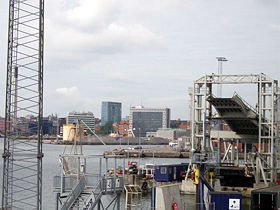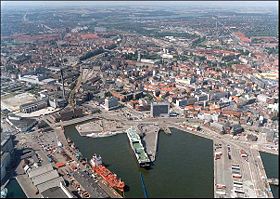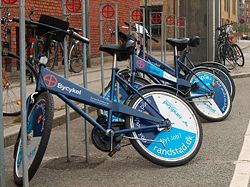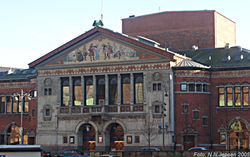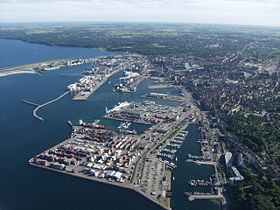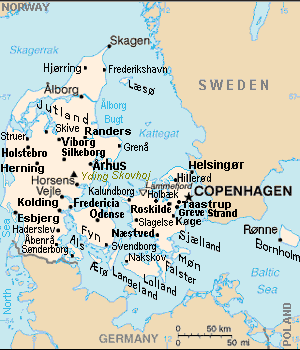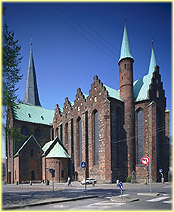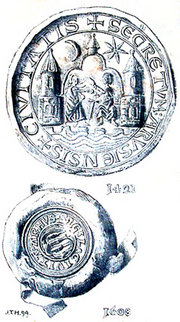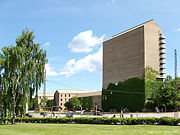Aarhus
2008/9 Schools Wikipedia Selection. Related subjects: European Geography
| City seen from the South Harbour | |
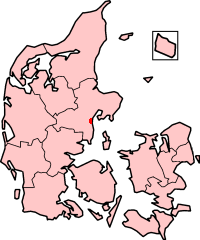
|
|
| Area | |
|---|---|
| - Inner city | 91 km² |
| - Municipality | 468 km² |
| - Urban | 1,909 km² |
| - Metropolitan | 5,842 km² |
| - East jutland metropolitan | 9,997 km² |
| Population ( Density) | |
| - inner city | 237,551 (2,610 km²) |
| - municipality | 298.538 (637 km²) |
| - Urban | 441.748 (231 km²) |
| - Metropolitan | 808,288 (138 km²) |
| - East jutland metropolitan | 1,212,781 (121 km²) |
| Additional information | |
| Time zone | Central European: UTC+1 |
| Latitude Longitude |
56°09' N 10°13' E |
Aarhus ( Danish pronunciation : [ˈɒːhus, ˈɒːhuːˀs]) also commonly known by its contemporary Danish spelling Århus, is the second largest city and the principal port of Denmark, situated on the peninsula of Jutland. Aarhus is the seat of the council of Aarhus municipality and claims the unofficial title "Capital of Jutland".
Geography
The city lies roughly at the geographical centre of Denmark on the peninsula of Jutland. Forests reach from the south into the city to within a kilometre (.6 mi) of the city centre, because the city has grown around the forest, and some areas are completely surrounded by the city, such as Risskov. The city is built mostly around the harbour, which is predominantly industrial, although a large recreational marina is situated south of it as an extension.
While some of the highest points in Denmark are close to the city, the general landscape is typically hilly, interspersed with forests and meadows; the city itself is very hilly north of the centre. The coastline consists mainly of sandy beaches, but stony areas are not uncommon. The immediate coastal regions are not heavily populated due to a national policy of keeping residences inland rather than crowding the coast.
The city lies at the junction of railway lines from all parts of the country. To the south west (about 21 km, 13 miles, by rail) lies a picturesque region that contains the Gudenå. Several larger lakes extend West from the Skanderborg railway junction and rise to heights exceeding 152 metres (499 ft) in the Himmelbjerget. The railway traverses this pleasant district of moorland and woodland to Silkeborg.
Transport
Aarhus Airport, a local airport of Aarhus, is located 40 km (25 mi) north-east of Aarhus, in Tirstrup. There have been plans for constructing a new, bigger airport for a long time, but so far, the plans have not been realized.
There have been plans for a new bridge between Aarhus and Kalundborg, to provide a better infrastructure between Jutland and Zealand, and especially Aarhus and Copenhagen. The government and the Minister of Transportation of Denmark has temporarily denied this request, and called it 'unrealistic'. One of his own current efforts for a 70-billion kroner bridge between Zealand and Germany, has been criticized for its lack for necessity and economic implications.
A survey by Aarhus Stifttidende suggested that as little as 8% of the people of Denmark would ever use the bridge to Germany, and that some 25% of the population would use the bridge between Aarhus and Zealand every month. The future of the bridge is being discussed by a cooperation between the municipality of Aarhus, nearby municipalities. Financial corporations in the private sector are interested in funding the project for profiting from the bridge in years to come. In Danish, the potential bridge is referred to as "Kattegat-broen", or the Kattegat-bridge, because it would be build across the Kattegat sea.
Aarhus is served by commuter rail that connects the city it self with nearby neighbouring cities. The main station in Aarhus is Århus Central Station, which is located in the city centre. There is also more than 20 stations in the inner city and in the suburbs.
History
The bishopric of Aarhus dates back to at least 951, and archaeological findings date back some 1300 years to Viking times. The city itself is presumably older than 770 AD, making Aarhus the oldest big city in Scandinavia. The favorable central position of the city within Denmark afforded it trade from Germany, the Baltic countries, the greater peninsula of Jutland and the communities on the many smaller islands in its vicinity, which meant that trade always had a great significance to the town - a significance which is still true today.
The city did not expand outwards until the late 19th century, and Aalborg remained the largest city on the peninsula until the 1920s. The relatively fast, albeit late, growth of the city can be ascribed to the general tendencies of a population moving from rural to urban areas during the industrial revolution. Industrialisation meant that proximity to trade routes became more important, giving the harbour city some advantages over other nearby cities as new industries came into existence.
Name
During the Middle Ages the city was called Arus, and in Icelandic chronicles, it was known as Áróss. It is a compound of the two words ār, genitive of ā ("river", Modern Danish å) and ōss ("mouth", obsolete in Modern Danish; in Modern Icelandic this word is still used for "river delta"). The city is located on the mouth of the small river, Århus Å (Å being the Danish word for a small river).
Through regular sound development, Medieval Danish Arus became Aars or Oes, a form which persisted in the dialects of the surrounding parishes until the 20th century. In 1406 Aarhus became prevalent in the written sources, and gradually became the norm in the 17th century. Aarhus is probably a remodelling after the numerous Low German place names in -husen, possibly as a result of the influence of German merchants.
The city is mentioned for the first time by Adam of Bremen who states that "Reginbrand, bishop of the church of Aarhus (Harusa)" participates in a church meeting in the city of Ingelham in Germany.
Viking Age and before
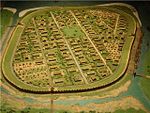
The oldest archaeological findings in Aarhus are glass pearls which date to the end of the 7th century. Half buried Long houses, used both as homes and workshops for the Vikings have also been found. In the houses and the adjoining archaeological layers, combs, jewelry and basic multi-purpose tools have been found that indicate the settlement is from approximately year 900. Digs in the spring of 2005 revealed a so-called city-ditch from the year 850 which might have marked the trade centre upon which the city is built.
The finding of six runestones in and around Aarhus indicates the city had some significance around year 1000 as only wealthy nobles traditionally used them. The centre of Aarhus was once a pagan burial site until Aarhus' first church, Holy Trinity Church, a timber structure, was built upon it during the reign of Frode, King of Jutland, around 900 CE.
17th-18th centuries
During the wars of the 17th century, it is probable that the city suffered in a significant way. Fortifications still exist south of the city as a reminder of the German imperial campaigns between 1627 and 1629. In 1644, Sweden taxed the city harshly and between 1657 and 1659, it was occupied by Swedish troops on several occasions.
In spite of these and other misfortunes, such as plague and city-wide fires, Aarhus was still quite a significant city in Denmark due to its favourable geographical position which was of significant importance for trading. Trade came mainly from the inland of Jutland but also from Norway, Lübeck, Amsterdam, England, France and Spain. In the middle of the 18th century the trade fleet consisted of approximately 100 ships.
19th century
In the 19th century, the city gained more independence from the dominance of Copenhagen and Hamburg. While it had been the third largest city in Jutland during the early 19th century, its population surpassed Randers in 1840 and in 1850, Ålborg, thus becoming the largest city in Jutland and the second largest in Denmark.
The city's material prosperity continued to increase as the harbour expanded and the railway network grew. Culturally, it marketed itself as the "Capital of Jutland" and expanded many of its cultural institutions like the national library, universities, the Aarhus Theatre and hospitals.
Main sights
- Århus Domkirke, the tallest and longest cathedral in Denmark.
- Church of Our Lady, a large church .
- Århus City Hall (City Hall of Århus).
- Aarhus Universitet (University of Århus).
- Statsbiblioteket (State library).
- Den Gamle By, an open air museum.
- Det Jyske Musikkonservatorium (The Juttish music conservatory).
- Botanisk Have (Botanical garden).
- Tivoli Friheden, amusement park.
- ARoS Aarhus Kunstmuseum, the main Århus arts museum.
- Aarhus Kunstbygning, an arts museum.
- Marselisborg Palace, the royal castle of Århus.
- Aarhus Theatre, the official theatre of the city.
- Aarhus Dyrehave, an open air park with deers and wild boar enclosures.
- Telecommunication Tower Aarhus, a 325 meter tall concrete tower with guyed mast on its top
- Skejby Sygehus, the second largest hospital in Denmark
- Atletion, a combinated sport venue
- Kvindemuseet i Danmark. Women's Museum in Denmark
- Light House (in construction). Expected to be completed in 2010, it will be Denmark's tallest building.
- Den Permanente a popular closed beach area, also providing views of Helgenæs and Samsø across Århus Bay.
- Naturhistorisk Museum, a natural history museum
- Moesgård Museum
- Viking Museum
Demographics
Almost 300,000 people live within the city limits of Aarhus, while an additional 500,000 live in the surrounding local area of the East Jutland region. Aarhus is also a part of the larger East Jutland metropolitan area with 1,200,000 inhabitants that makes East Jutland the second most-populated area in Denmark, after the Copenhagen area.
Aarhus is divided into several districts and suburbs with its own postal code (Postdistrikter).
Districts (boroughs) inside the 2nd city beltway:
- Århus C
- Århus N
- Århus V
- Åbyhøj
- Viby
|
|||||
65,000 of the population of Aarhus are under 18 years of age. Aarhus has been growing at a steady rate of about 1% per year since 1950, when the city had about 150,000 inhabitants. The University of Aarhus estimates an increase of around 20,000 more students in the next six years, with attendant concerns over a lack of housing. In response, the city council has already initiated a large range of building projects in order to house some 100,000 new citizens before 2030 so the city population will rise to almost 400,000 inhabitants.
The population of Aarhus is both younger and better-educated than the national average, which is often attributed to the high concentration of educational institutions and facilities in the area.
Nearly 12% of the population are immigrants, which is high for Denmark, but modest when compared to some other European cities. The largest immigrant groups in 2005 were Lebanese (4,368), Turks (3,936), Somalis (3,113), Iraqis (2,728), and Iranians (2,188). These groups live mainly in the western parts of Aarhus, where the Gellerup area is famous for its high concentration of immigrants (88%, 2006). The vast majority of the immigrants in Gellerup are Arabs, Turks and Somali. Other large groups include Vietnamese (2,373), Poles (1,368), Germans (1,490), Afghans (1,134), Norwegians (1,111), and Britons (745).
Culture
Aarhus is a centre for education on the peninsula of Jutland drawing students from a large area, especially from the western and southern parts of the peninsula. The relatively large influx of young people and students creates a natural base for cultural activities and there are many cafes and restaurants as well as discoteques, cinemas, museums, amusement parks and various other venues of entertainment. Each year the town hosts several festivals and concerts including Aarhus International Jazz Festival and Aarhus Festuge the biggest festival in Scandinavia. The Vestereng park facility is also a site for large popular music concerts.
One major tourist attraction in Aarhus is The Old Town ( Danish: Den Gamle By), which is not actually an old part of the city itself, but a collection of historic Danish buildings gathered from all around the country. The city also hosts the Tivoli Friheden amusement park as well as the Deer Park situated in the large nearby public forest.
Architecturally impressive sights include the 13th century cathedral in the centre of the city; Århus Domkirke is the tallest cathedral in Denmark, as well as the second tallest in Northern Europe, being only 45 cm (18 in) shorter than its counterpart in Trondheim. The Aarhus City Hall is a uniquely designed building drawn by renowned architect Arne Jacobsen, located in the city centre. The city hall is included in the national educational canon for culture as an example of important architectural work.
There are many museums scattered around the city with ARoS being the newest and largest featuring daily exhibits of contemporary art. Other museums include Aarhus Kunstbygning also featuring mostly contemporary art, Frihedsmuseet focusing on the occupation and resistance movement during World War II and Kvindemuseet mainly showcasing feminist history and culture.
Being a comparably large Danish city, Aarhus has received a fair share of immigrants from various other cultures and is as such also home to one of the few ghettos in Denmark, Gellerup. The international cultures present in the community are an obvious and visible part of the city's daily life and contribute to many cultural flavours uncommon for the North, such as the Arabic themed Bazar West, a market with shopkeepers predominantly of foreign descent.
The city has an active and visible gay and lesbian community which the city officially attempts to promote and nurture. The Aarhus Festuge festival usually includes several exhibits, concerts or events specifically designed for these communities. There are several clubs, discos and cafes aimed at gays and lesbians: Danish D-lite (sports), Diskotek Blender (disco) or Gaia Vandreklub (hiking club) are a few examples.
It is common for tourist brochures and local politicians to refer to the town with the tongue-in-cheek slogan "The worlds smallest city"reflecting the fact that the city has everything a city needs while unquestionably not a metropolis. Another popular, and perhaps better known phrase to describe the city, is "City of Smiles" - a slogan first coined by the city council in the 1930s as an advertising slogan, and which subsequently is used widely in popular culture today.
Sports
In the southern-Aarhus Marselisborg Park, the sports centre named Atletion is located comprises athletics, the football NRGi Park and the indoor sports NRGi Arena. Several sport clubs have their home ground in Atletion, including Aarhus Gymnastikforening, the Danish superliga football team, and Aarhus GF handball team, the 1960 European Cup runner-up. Although basketball is a minor sport in Denmark, Aarhus is considered the main Danish hub of the sport, with the local team Bakken Bears being the most successful team in Denmark for the past decade.
Aarhus (and especially Atletion) has served or will serve as the host of many sport events in recent years including:
- 2002 European Women's Handball Championship
- 2005 European Table Tennis Championships
- Denmark Open in badminton
- UCI Women's Road Cycling World Cup
- 2006 World Orienteering Championships
- 2006 World Artistic Gymnastics Championships
- GF World Cup; the world's largest handball tournament for women
- DanceSport IDSF World Standard 2006
Education
The town is home to the University of Aarhus, Aarhus School of Business, Aarhus Technical College, The Danish School of Journalism and the Engineering College of Aarhus and several other high-end education centres. It is possible to receive higher education in many areas, from engineering and dentistry to language and theology. The Danish School of Journalism is considered one of the most prestigious journalism schools in Europe.
The University of Aarhus has approximately 40,000 students in the city and 30,000 students at the university with approximately 5,000 new students per year.
Politics
The city council consists of 31 members elected for 4-year terms. Anybody eligible to vote and residing in Aarhus municipality can run for a seat on the city council. After elections have determined the members of the city council, the council elects a mayor, 2 deputy mayors and 5 councilmen. The current Mayor of Aarhus is Nicolai Wammen of the Social Democrats elected by the city council after the 2005 municipal elections.
The city is divided into 6 minor administrative bodies which together constitute the magistrate led by the mayor and the 5 elected councilmen as political and administrative directors. The 6 magistrate departments of the city are the “Mayor’s Magistrate”, “Social and Employment Magistrate”, “Technology and Environment Magistrate”, “Health and Social Magistrate”, “Culture and Service Magistrate” and “Children and Youth Magistrate” and handle all the day-to-day operations of the city.
Aarhus is the seat of Aarhus Municipality. Until the 2007 Danish Municipal Reform, which replaced the Danish counties with five regions, it was also the seat of Aarhus County, which has now been disbanded in favour of the new Region Midtjylland, its seat located in Viborg.
Aarhus has twinning agreements with Goteborg, Aabo, Bergen, Harbin, St. Petersburg and Julianehåb; and has a connection with Swansea.
Suburbs
|
|||||
Industry and business
The harbour is one of the largest industrial harbours in Northern Europe and the largest in Denmark. The facilities are very modern and handle app. 12.000.000 tons of cargo(2006) and are therefore among the 100 biggest containerports in the world. Much agricultural produce is exported, while coal and iron are among the chief imports. The harbour itself is maintained by Århus Stevedore Kompagni A/S originally based in Aarhus but currently operating several harbours around the world.
The region is a major producer of agricultural products with many large farms in the outlying districts. Cattle, pork and grain are the main products with a sizable related refinement industry present. Computer and technology heavy industries are mainly focused in the urban areas with an abundance of small and medium sized IT and service companies dotting the city centre.
The Ceres Brewery, part of Royal Unibrew, was originally founded in Aarhus. Royal Unibrew has recently announced the closure of Ceres, which will take effect by the end of 2008.
Famous people
- Ole Barndorff-Nielsen, mathematician
- Tina Dickow, singer
- Ida Corr, singer
- Lene Hau, physicist
- Thomas Helmig, singer
- Gitte Hænning, singer and film star
- Camilla Martin, badminton world champion
- Kaare Norge, guitarist
- Flemming Povlsen, footballer
- Marc Rieper, footballer
- Ole Rømer, astronomer
- Jens Christian Skou, Nobel laureate
- Bjarne Stroustrup, computer scientist
- Stig Tøfting, footballer
- Ole Worm, physician, scholar and antiquarian
